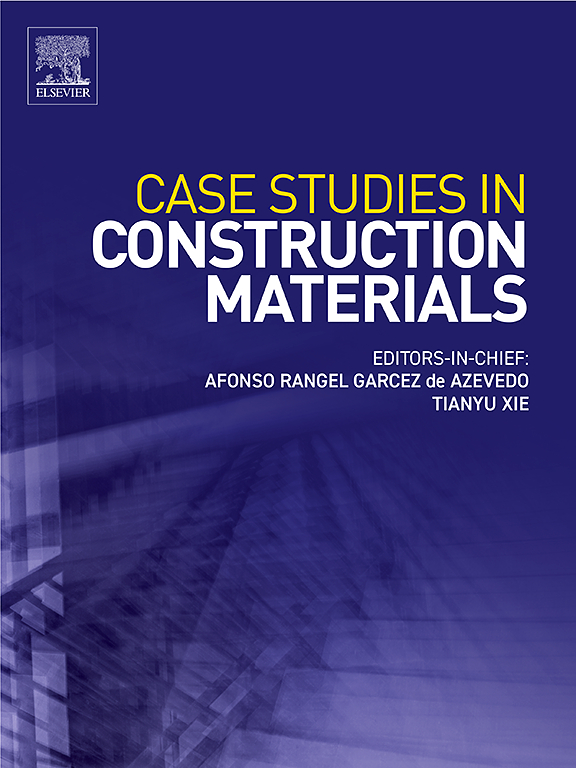根据松散集料的颗粒迁移和分布特征,建立了新的振动压实质量指标
IF 6.5
2区 工程技术
Q1 CONSTRUCTION & BUILDING TECHNOLOGY
引用次数: 0
摘要
作为发展海绵城市和改善排水性能的举措的一部分,具有大空隙的未粘结骨料(UAMs)越来越多地用于建设路面基层和下层。然而,在振动载荷诱导的粒子重排过程中,粒子的运动和动能的空间分布尚不清楚。本研究介绍了在不同振动参数组合和不同砾砂比(G/S)水平下,对UAM试件进行室内振动板压实试验的结果。在试件内嵌入SmartRock (SR)传感器,实时监测颗粒运动,并根据SR传感器采集的加速度时程信号分析运动能量及其空间分布。基于高精度工业x射线计算机断层扫描(XCT)和三维(3D)重建技术,分析了粗颗粒的运动和迁移特征。提出了一种基于颗粒运动和运动能的压实指标来评价试件的压实质量。研究结果表明,振动压实可分为三个不同的阶段。在第一阶段,粗颗粒主要是垂直运动,能量耗散主要通过压缩空隙进行,但没有形成致密的骨架结构。在第二阶段,粗颗粒在垂直旋转的同时水平移动,导致颗粒倾向于与它们的长轴水平对齐。在这个阶段,耗散的运动学能量主要用于填充空气空隙,导致形成密集的骨架结构。运动学能量指标和颗粒在试样中间的运动可以用来评价压实阶段和压实质量。此外,试样内的横向颗粒运动从连续上升过渡到逐渐下降(即以最小的运动学能量达到顶峰),从而表明相对致密的压实状态。减小孔隙率,增大4.75 ~ 9.5 mm和2.36 ~ 4.75 mm粒径范围内颗粒间的接触面积,可显著提高未粘结路面基层/次基层的压实密度,提高稳定性和抗变形能力。该研究结果为振动压实机理提供了有价值的见解,可用于优化压实方法和改善路面性能。本文章由计算机程序翻译,如有差异,请以英文原文为准。
Novel vibratory compaction quality indices developed from particle migration and distribution characteristics for unbound aggregate materials
Unbound aggregate materials (UAMs) with large air voids are increasingly used to construct pavement base and subbase layers as part of the initiative to develop sponge cities and improve drainage performance. However, the motion of particles and the spatial distribution of kinetic energy during the particle rearrangement process induced by vibratory loading remain unclear. This study presented the results of laboratory vibratory plate compaction tests conducted on UAM specimens under various combinations of vibratory parameters and different levels of Gravel to Sand ratio (G/S). SmartRock (SR) sensors were embedded within the specimens to monitor real-time particle motion, while kinematic energy and its spatial distribution were analyzed from the acceleration time-history signals collected by the SR sensors. Based on high-precision industrial X-ray computed tomography (XCT) and three-dimensional (3D) reconstruction technology, the motion and migration characteristics of coarse particles were analyzed. A new compaction index was proposed based on particle motion and kinematic energy to evaluate the compaction quality of the specimens. The findings of this study reveal that vibratory compaction can be divided into three distinct stages. During the first stage, coarse particles primarily move vertically, while energy dissipation occurs mainly through the compression of air voids but does not form a dense skeleton structure. In the second stage, coarse particles translate horizontally while rotating vertically, resulting in a tendency of the particles to align horizontally with their long axes. During this stage, dissipated kinematic energy is primarily used to fill air voids, leading to the formation of a densely packed skeleton structure. Kinematic energy indices and particle movement in the middle of the specimens can be used to evaluate the compaction stage and quality. Additionally, the lateral particle motion within the specimens transitions from continuous ascent to gradual descent (i.e., culminating in minimal kinematic energy), thus indicating a relatively dense compaction state. Reducing the void ratio and increasing the contact area between particles within the size ranges of 4.75–9.5 mm and 2.36–4.75 mm can significantly increase the compaction density and improve the stability and deformation resistance of unbound pavement base/subbase layers. The results of this study provide valuable insights into the mechanisms of vibratory compaction and can be used to optimize compaction methods and improve pavement performance.
求助全文
通过发布文献求助,成功后即可免费获取论文全文。
去求助
来源期刊

Case Studies in Construction Materials
Multiple-
CiteScore
7.60
自引率
19.40%
发文量
842
审稿时长
63 days
期刊介绍:
Case Studies in Construction Materials provides a forum for the rapid publication of short, structured Case Studies on construction materials. In addition, the journal also publishes related Short Communications, Full length research article and Comprehensive review papers (by invitation).
The journal will provide an essential compendium of case studies for practicing engineers, designers, researchers and other practitioners who are interested in all aspects construction materials. The journal will publish new and novel case studies, but will also provide a forum for the publication of high quality descriptions of classic construction material problems and solutions.
 求助内容:
求助内容: 应助结果提醒方式:
应助结果提醒方式:


